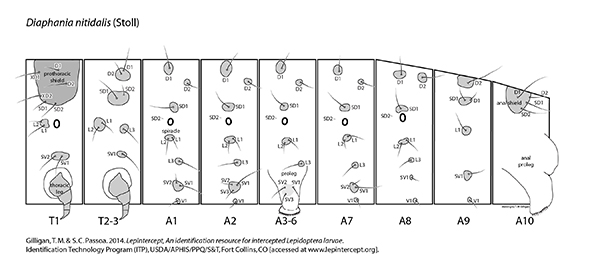CRAMBIDAE - Diaphania nitidalis (Stoll) *Non-Rep*
Taxonomy
Pyraloidea: Crambidae: Spilomelinae: Diaphania nitidalis (Stoll)
Common names: pickleworm
Synonyms: Diaphania vitralis
Larval diagnosis (Summary)
- Genal spot is present
- SV group on A1 is bisetose
- Mandible lacks an outer tooth (projection)
- Crochets on A3-6 in a mesal penellipse
- No black spot posterior to the SD2 seta on the prothorax
- Early instars have pigmented pinacula and a thick dark oval on the prothoracic shield
- Late instars have pale pinacula and an unmarked prothoracic shield
Host/origin information
Diaphania nitidalis is commonly intercepted on Cucumis, Cucurbita, and Sechium (cultivated cucurbits; Cucurbitaceae)
from Central America. More than 93% of the interception records in PestID are from the following origin/host combinations:
| Origin |
Host(s) |
| Costa Rica | Sechium |
| Dominican Republic | Coccinea, Cucurbita, Sechium |
| Guatemala | Cucurbita, Sechium |
| Haiti | Cucurbita, Sechium |
| Honduras | Cucumis |
| Mexico | Cucumis, Cucurbita, Sechium |
Recorded distribution
Diaphania nitidalis is distributed throughout the New World tropics. Individuals move into temperate areas during the summer but are unlikely to overwinter
outside of tropical or subtropical regions. This species is also found in Hawaii.
Identification authority (Summary)
Origin and host are important information for making positive identifications of this species. There are no confirmed records of D. nitidalis outside of the New World
(and Hawaii), so identifications should be restricted to larvae originating from these locations on cultivated cucurbits.
Pest characterization
(Based on Cavey 2001, Passoa 1985)
- Taxonomy: High. Species identification is often possible.
- Distribution: Low. Diaphania nitidalis is present in the U.S.
- Potential Impact: High. Diaphania nitidalis is a serious pest.
This ranking characterizes Diaphania nitidalis as not quarantine significant for the U.S.
CRAMBIDAE - Diaphania nitidalis (Stoll) *Non-Rep*
Larval diagnosis (Detailed)
The larva of D. nitidalis, the pickleworm, was partially described by Peterson (1962), Negm (1968), Weisman (1986), Neunzig (1987),
Solis (1999, 2011) and Schnitzler et al. (2011). Passoa (1985) included setal maps for both the early and late instars. Color photographs
can be found in King and Saunders (1984), Passoa (1985), Sparks and Liu (2001) and Heu et al. (2005).
Typically, the larva of D. nitidalis has a genal spot, the SV group of A1 bisetose, no outer tooth on the mandible, the crochets of
A3-6 in a mesal penellipse and no black spot posterior to the SD2 seta on the prothorax (Passoa 1985). The D1 setae are longer than D2
on A1-7, but on A8 the situation is reversed, D2 is longer than D1. The early instars have pigmented pinacula and a characteristic pattern
on the prothoracic shield forming a thick oval. Both early and late instars have the V1 pinaculum of A3-6 bandlike and SD1 on A2 and A7
are normal in size.
Unlike D. hyalinata and D. indica, D. nitidalis lacks an outer tooth (projection) on the mandible above the lateral setae and has a genal spot.
Live larvae of D. nitidalis lack the white subdorsal longitudinal stripes found in D. hyalinata and D. indica.
Both the D. hyalinata-indica complex and D. nitidalis have a row of microspines at the base of the proleg, but the distribution of this character in
Crambidae has not been studied.
Identification authority (Detailed)
Because hundreds of species of pyraloids could have the major features of D. nitidalis (no outer tooth, a genal spot and bisetose SV
group on A1), host and origin are important clues for identification of this species. Except for Hawaii (Heu et al. 2005), there are no
confirmed records for D. nitidalis outside of the New World. Hosts are always curcurbits, other records are potential misidentifications
of the caterpillar or host. Diaphania nitidalis is considered a complex (CIE 2000), but apparently none of the sibling species are found
on crop plants. Therefore, restrict identifications of D. nitidalis to New World and Hawaii interceptions on cultivated cucurbits until
other closely related species are studied more closely.
CRAMBIDAE - Diaphania nitidalis (Stoll) *Non-Rep*
Origin records
Diaphania nitidalis has been intercepted from the following locations:
Armenia, Bahamas, Bangladesh, Brazil, Canada, Colombia, Costa Rica, Dominica, Dominican Republic, Ecuador, El Salvador, Guadeloupe,
Guatemala, Haiti, Hawaii, Honduras, India, Iran, Jamaica, Mexico, Panama, Peru, Puerto Rico, Romania, Senegal, Suriname,
Trinidad and Tobago, Turkey, Uruguay, Venezuela, Zimbabwe
Locations from outside of the New World (and Hawaii) likely represent misidentifications.
Host records
Diaphania nitidalis has been intercepted on the following hosts:
Abelmoschus esculentus, Abelmoschus sp., Amaranthus sp., Annona cherimola, Apium graveolens, Artocarpus altilis,
Artocarpus heterophyllus, Benincasa hispida, Brassica pekinensis, Brassica sp., Cajanus cajan,
Capsicum annuum, Capsicum sp., Carica papaya, Chamaedorea sp., Chenopodium berlandieri ssp nuttalliae,
Chenopodium sp., Cichorium intybus, Citrus aurantiifolia, Coccinea grandis,
Coccinia sp., Cocos nucifera, Colocasia esculenta, Coriandrum sativum, Cucumis anguria, Cucumis melo,
Cucumis melo var. inodorus, Cucumis sativus, Cucumis sp., Cucurbita maxima, Cucurbita moschata, Cucurbita pepo,
Cucurbita sp., Cucurbitaceae, Cyamopsis sp., Cyamopsis tetragonoloba,
Dianthus sp., Diospyros virginiana, Inga sp., Lactuca sp., Lagenaria siceraria, Lepidium sp.,
Leucaena pulverulenta, Lilium sp., Luffa acutangula, Luffa sp., Malus domestica, Mangifera indica, Manihot esculenta,
Manilkara zapota, Mentha piperita, Mentha sp., Momordica balsamina, Momordica charantia, Momordica sp.,
Murraya koenigii, Musa sp., Nicotiana tabacum, Ocimum basilicum, Olea europaea, Opuntia sp.,
Phaseolus sp., Phaseolus vulgaris, Physalis ixocarpa, Physalis philadelphica, Physalis pubescens, Physalis sp.,
Piper sp., Pongamia pinnata, Pouteria sapota, Prunus domestica, Quercus sp.,
Rumohra sp., Sechium edule, Sechium sp., Solanaceae, Solanum aethiopicum, Solanum lycopersicum var lycopersicum,
Solanum melongena, Solanum quitoense, Solanum sp., Spinacia oleracea, Spondias sp., Urtica sp.,
Vigna unguiculata, Xanthosoma sp., Zea mays
Hosts listed above that are not cultivated cucurbits need verification. Trees (oak, citrus), monocots (lily), and Opuntia are especially suspect.
CRAMBIDAE - Diaphania nitidalis (Stoll) *Non-Rep*
Setal map
 Diaphania nitidalis setal map Diaphania nitidalis setal map
<< Previous fact sheet Next fact sheet >>
|
|
|
|
|